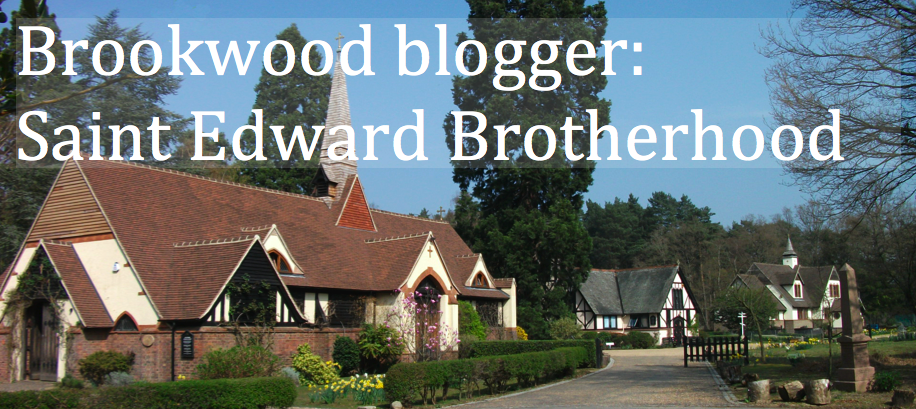THIS YEAR, the anniversary of the Enshrinement of the Sacred relics at
Brookwood fell on a Sunday (3rd / 16th September) and His Grace, Bishop
Ambrose of Methoni came to England to be with us. On the Saturday,
the Bishop celebrated the Divine Liturgy at the Convent of the Annunciation,
and there we were joined by Archimandrite Ieronymos from Jordan, a
clergyman of the the Patriarchate of Jerusalem, who prayed within the
altar during the service. Fr Ieronymos, as Bishop Ambrose told the
faithful at the end of the Liturgy, had know His Grace from childhood.
The Bishop remarked in his sermon that the previous day had been the Church New
Year, and that the Gospel appointed for the Saturday was about an ending, the
Saviour’s prophecy concerning the destruction of the Temple at Jerusalem.
He pointed out that for us everyday should be an ending and a beginning: an
ending to our sinful ways and a new beginning in repentance and in Godliness.
After the Liturgy, Mother Vikentia and her sisters kindly treated all to
a breakfast in their main trapeza. Bishop Ambrose invited Fr Ieronymos to
come with us to Brookwood to see the Brotherhood, though he had to be back in
London that evening. En route we called by the Russian Church of the
Dormition on Harvard Road, where we found Archpriest Vladimir Vilgerts talking
with some parishioners in the church and so we were able to show our guest from
Jordan the church and venerate the holy things there, and on reaching Brookwood
we showed Fr Ieronymos our church and the workrooms, etc, here, and offered him
some refreshments before taking him to the station to enable him to return to
London for his appointment there.
In the evening our
congregation at the Vigil was joined by a group of pilgrims from the Russian
Orthodox Cathedral at Ennismore Gardens, London. His Grace led the
prayers at the liti, and at the polyeleos. At the end of the service, he
gave a short address about the significance of St Edward. On Sunday
morning, His Grace, Bishop Sofronie of Suceava arrived from Romania, and
the two hierarchs concelebrated with the Brotherhood clergy. Again we were
joined by pilgrims from Ennismore Gardens and other Orthodox churches, and by
some Anglcans from Corfe in Dorset, where St Edward had been slain. After
the vesting of the Bishop, and the reading of the Hours, Bishop Ambrose
tonsured Borislav Popov from Chatham a reader and made him a
subdeacon. During the Divine Liturgy, after the Gospel, His Grace
preached about the close connection between the love of God and love of one’s
neighbour, illustrating his point with an incident from the life of St Basil
the Great. He then continued, speaking again about St Edward, his life,
his championing the monastics, and the importance of the monastic life.
For this service the church was packed, and apparently many people could not
get in. It has been described by one person as a feast for sardines and slim
ones at that! At the end of the Divine Liturgy we had the Lesser
Blessing of Waters, and all those who attended were sprinkled with the holy
water and give the antidoron. Through the kindness of our parishioners, a
buffet meal was then provided in the Old Mortuary, but the Bishops quickly
returned to church where they celebrated the Baptism of Antonie Costin of
Colindale, the infant son of Nicolae and Daniela Costin. His
godfather was Vasile Costin. After the Baptism and churching,
Antonie was imparted the holy Mysteries of the Body and Blood of our
Saviour. Bishop Sofronie then left us, but Bishop Ambrose stayed some
time to meet our parishioners and talk with them individually. Throughout
the afternoon individuals and couples, who had attended Divine services in
their own parishes in London, came to pray in the church on the Saint’s day,
including two families from nearby who had just found us on the internet.
Doubtless the grace of the Saint drew them on that day. I do not think it
is an exaggeration to say that never since the sacred relics of St Edward were
given to our church twenty-eight years ago, have we had such a feast for his
day or so many people attend. The archpastoral love that our hierarchs showed
us in leading the celebrations undoubtedly contributed to this, and for this we
are truly grateful. Glory be to our God! And Many
Years to the Newly-Illumined Antonie, his sponsor Vasile, and
to our new Subdeacon Borislav, his wife, Marina, and their
family! Please keep them all in your prayers.
